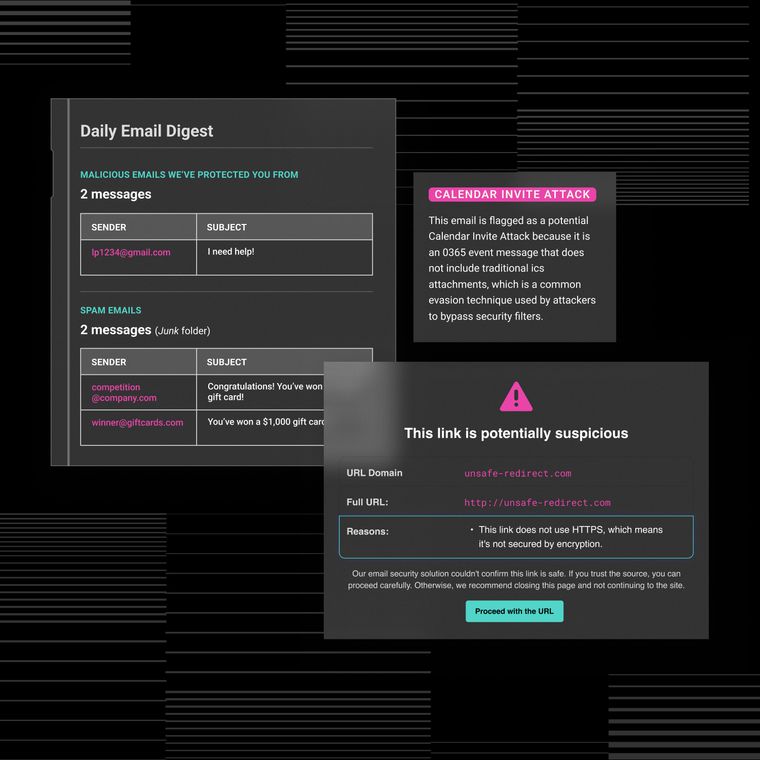How Threat Actors Weaponize Google Translate for Phishing
Learn how attackers use Google Translate's URL redirection for phishing, exploiting Google’s trust to deceive users and bypass security.
January 10, 2025

Phishing attacks are becoming increasingly sophisticated and difficult to detect, often exploiting well-known and trusted platforms to manipulate users and evade standard security defenses.
A prime example is the misuse of Google Translate's URL redirection functionality. Attackers are leveraging the inherent credibility of Google's domain to create links that seem authentic, increasing the likelihood that users will engage with harmful content.
In this post, we’ll explore how attackers abuse Google Translate redirects, examine the underlying methods behind this approach, and discuss what this means for both cybersecurity professionals and everyday users.
Phishing via Google Translate
Google Translate is a popular service that allows users to translate web pages and text into different languages. When you enter a URL into Google Translate, it generates a new link, redirecting the user through its platform to the requested page. This allows users to seamlessly view translated content from other websites within the familiar Google Translate interface, keeping the user experience consistent.
The way Google Translate creates these redirects is simple: it takes the original URL and appends it to a new domain (like translate.goog), along with some additional parameters. Unfortunately, this process also opens a door for attackers to exploit this redirection feature for malicious purposes.

A forum thread discussing phishing using Google Translate
Phishers are taking advantage of this by hiding harmful websites behind seemingly legitimate Google URLs. They host phishing pages on untrustworthy domains and then create Google Translate redirects that mask the malicious URLs. By presenting a link that includes the trusted Google domain, attackers reduce the likelihood that users will recognize the malicious intent, as the link appears harmless and trustworthy.
Analyzing Redirect Loopholes
Exploiting Google Translate's redirect feature involves several steps that enable attackers to disguise phishing links as legitimate Google URLs. Here’s a simplified breakdown of the process:
Step 1: Domain Encoding
- Attackers modify the phishing domain to fit within Google Translate's URL parameters. For example, they change periods (.) in the domain name to hyphens (-), making example.com appear as example-com.
- They then append .translate.goog to the altered domain, resulting in a URL that starts with example-com.translate.goog.
Step 2: Parameter Manipulation
To complete the URL, attackers add specific Google Translate parameters:
- _x_tr_sl=auto tells Google Translate to detect the source language.
- _x_tr_tl=en sets the target language to English.
So, the final URL would look like:
https://example-com.translate.goog/?hl=en&_x_tr_sl=auto&_x_tr_tl=en
Step 3: Mass Link Distribution
These altered links are then distributed via phishing emails or social media messages. The inclusion of ".goog" creates a false sense of security, leveraging the trust users place in Google's domain.

Example of Google Translate banner increasing appearance of legitimacy
The site also appears under Google’s domain, often complete with a Google Translate banner at the top, which further enhances its perceived legitimacy.
Google Translate Redirect Risks
This kind of Google Translate redirect abuse poses a significant cybersecurity risk and has wide-ranging implications:
Exploiting End-User Trust
The .goog domain is often trusted by users, making these phishing links highly effective. Many victims may fail to scrutinize the URL, assuming it is legitimate.
Bypassing Security Protocols
Traditional email filters and web proxies often rely on domain reputation to flag malicious links. Since these links originate from Google’s domain, they are less likely to trigger warnings or be blocked.
Masking Malicious Links
Encoding phishing domains into Google Translate URLs effectively masks their true destination, making it more difficult for both users and automated security tools to detect the threat.
Google’s Reputation Risk
The misuse of Google Translate for malicious purposes places Google in a difficult position. While the service certainly offers valuable benefits, its abuse could harm Google’s reputation as a trusted technology provider.
How to Mitigate Phishing Attacks Utilizing Google Translate
Carefully examining URLs is the first line of defense. Always take a moment to review the entire link before clicking, particularly looking out for encoded domains or odd usage of tools like Google Translate within the URL. If something feels off, it's better to err on the side of caution and avoid entering sensitive credentials on sites reached through unexpected redirects.
For organizations, it’s important to configure email and web filters to thoroughly analyze full URL paths, including any redirects or encoded domains. Alongside this, invest in consistent employee training to raise awareness about how attackers may leverage trusted platforms, such as Google Translate, to facilitate phishing schemes.
Stop Phishing Attacks with AI-Native Security
Abnormal Security goes beyond traditional solutions by leveraging advanced AI to detect and block phishing attempts that exploit trusted platforms like Google Translate.
Abnormal’s AI-native solution continuously learns the communication patterns of employees and vendors, using behavioral data to detect subtle anomalies indicative of advanced threats and stopping malicious emails before they ever reach the inbox. Don't let attackers exploit your employees' trust in familiar services. Learn how our innovative approach can protect your organization from these tactics and ensure your cybersecurity infrastructure remains strong against threats.
See for yourself how Abnormal AI provides comprehensive email protection against attacks that exploit human behavior. Schedule a demo today.
Related Posts
Get the Latest Email Security Insights
Subscribe to our newsletter to receive updates on the latest attacks and new trends in the email threat landscape.


